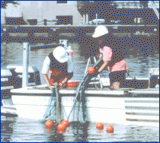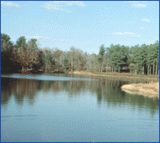Key Concepts Module 2: Use
This module addresses waterbody uses and provides definitions and examples of various types of uses.
-
What are designated uses?
-
What are existing uses?
-
What options do States and Tribes have in defining designated uses?
At the end of the module is a brief quiz intended to touch on some Core Modules regarding designated uses that are further examined in the classroom session of this module.
This module's main pages and brief quiz at the end take about 15 minutes to complete.
The Uses of a Water Body
The "use" of a water body is the most fundamental articulation of its role in the aquatic and human environments.
The "designated" uses of a water body are an expression of goals for the water, such as supporting aquatic life and human activities, including recreation and use as a public water supply. That is, these uses may not currently be attained for the water body.
Key Point. Designated uses are those uses specified in water quality standards for each water body or segment whether or not they are being attained.
Key Point. The concept of a water body having designated uses—that is, desirable and attainable uses as defined in this module - is central to establishing appropriate water quality standards (63 FR 36749, July 7, 1998).
A water body's designated uses are important because:
- Taken together, they articulate the vision for the water body.
- They establish the water quality management goals for the water body.
- If they are wrong, everything else is wrong.
Key Point. Designated uses are incorporated into State/Tribal law. They are used to determine water quality criteria, which serve as the basis for discharge permit limits.
Integrity of the Nation's Waters
The overall objective of the Clean Water Act (CWA) is to restore and maintain the chemical, physical, and biological integrity of the Nation's waters.
Key Point. Under the Clean Water Act, States and authorized Tribes have the primary responsibility for identifying the uses of their water bodies and for adopting these uses into their water quality standards.
Aquatic Life and Recreation
Section 101(a)(2) of the Clean Water Act states that, as an interim goal, water quality should provide for the protection and propagation of fish, shellfish and recreation in and on the water, wherever attainable. This is sometimes referred to as the "fishable/swimmable where attainable" goal—but it should not connote that "fish" are only valuable for "fishing" or other human use.
Section 303(c)(2)(a) requires States/Tribes developing standards for waters to adopt standards that "shall be such as to protect public health or welfare, enhance the quality of the water and serve the purposes of [the CWA] AND, in establishing such standards, consider their use and value for public water supplies, propagation of fish and wildlife, recreational, agricultural, industrial, and navigation and other purposes."
Concepts Applied. Read how designated uses were written into the Tribal water quality standards for Pueblo of Acoma in New Mexico (PDF) (55 pp, 3 MB, About PDF)
CWA 101(a)(2) Uses
The Water Quality Standards regulations effectively establish a "rebuttable presumption" that the CWA 101(a)(2) uses are attainable and therefore must be assigned to a water body, unless a State or Tribe affirmatively demonstrates, with appropriate documentation, that such uses are not attainable.
Key Point. Along with facilitating achievement of Congress' goals, the "rebuttable presumption" approach preserves the paramount role of States and Tribes in establishing water quality standards and in weighing any available evidence regarding the attainable uses of a particular water body.
Resources. EPA's website on the Clean Water Act.
To rebut the presumption, a State or Tribe must rely on a "use attainability analysis."
Key Point. A use attainability analysis is a structured scientific assessment of the factors affecting the attainment of the use, which may include physical, chemical, biological, and economic factors as described in Sec. 131.10(g).
The Basis for State/Tribal Water Quality Goals
"Designated uses" (defined in 40 CFR 131.3(e)) are uses specified by a State or Tribe in its water quality standards regulations for each water body or segment, regardless of whether the uses are currently being attained. These uses describe the State/Tribe's management objectives and expectations for its waters and allow the State/Tribe to work with its stakeholders to identify the collective goal.
Question. Why should designated uses describe something other than the current conditions of a water body?
Because designated uses are the goals for a water body. Environmental controls are used to work toward any goals not currently attained.
EPA's regulations are structured to ensure that States and Tribes designate appropriate uses reflecting both the current conditions, past conditions, and the potential of a water body to attain a use even if it is not being attained currently. These are goals to strive for. Without goals, there will be no movement toward the CWA goal to restore and maintain the Nation's waters.
Key Point. Consistent with the objective of the CWA to maintain and restore the physical, chemical, and biological integrity of our nation's waters is the intention to reflect the highest attainable use, whether or not it is currently being attained.
The Uses Already Attained by a Water Body
Existing uses (defined in 40 CFR 131.3(e)) are uses that were "actually attained" in a water body on or after November 28, 1975—the day EPA promulgated the original water quality standards regulation.
-
Historical/current water quality.
-
Historical/current biological condition.
-
Pattern, frequency, and type of use.
Use Subcategories
A State/Tribe can adopt subcategories (and/or seasonal classifications) in its use classification system to further refine designated uses. For example, a State may choose to adopt subcategories to differentiate between coldwater and warmwater fisheries.
Key Point. Subcategories and seasonal uses are often used because determining water quality criteria to appropriately protect waters with broad use categories might be difficult or open to various interpretations.
Key Point. Economics may be factored into water quality standards when establishing designated uses and determining the "attainability" of those uses, not when developing water quality criteria.
Subcategories for Section 101(a) Goal Uses
Protection and propagation of fish, shellfish, and wildlife
Considered a CWA "interim goal." To protect aquatic life uses, different uses and criteria may be established to differentiate between coldwater and warmwater fisheries.
Recreation in and on the water
-
Primary Contact. Protects people from illness due to immersion in water. May include swimming, water-skiing, skin diving, and surfing—all activities where ingestion is likely.
-
Secondary Contact. Protects people when engaging in activities where ingestion is unlikely, such as boating and wading. These subcategories may be further divided.
Key Point. States may adopt seasonal uses as an alternative to reclassifying a water body or segment thereof to uses requiring less stringent water quality criteria. If seasonal uses are adopted, water quality criteria should be adjusted to reflect the seasonal uses, however, such criteria shall not preclude the attainment and maintenance of a more protective use in another season. (Sec. 131.10(f))
Section 303 Other Uses
| Other Uses | Descriptions |
|---|---|
| Public water supply | Waters that are the source of a raw water supply. That is, water supplied to a drinking water treatment system, not for direct consumption. This use can be categorized for various levels of treatment. |
| Agricultural | Waters that are suitable for irrigation of crops, consumption by livestock, support of vegetation for range grazing, and other uses in support of farming and ranching operations. |
| Industrial | Provides protection for cooling and process water supplies, but not treatment for industrial wastes. Specific criteria would depend on the specific process involved. |
| Navigation | Provides protection of waters for shipping and sailors, so as not to prevent or restrict navigation. |
Resource. The "Blue Book" (Water Quality Criteria, 1972) EPA R3-73-033, March 1973).
Other Purposes Category
| Other Purposes | Descriptions |
|---|---|
| Ceremonial uses | Reflects unique exposure patterns and pathways for tribes (e.g., Pueblo of Isleta). |
| Shellfish grazing areas | Addresses shellfish beds and oyster harvesting in all coastal States. |
| Protection of endangered species | Special level of protection for waters with known populations of endangered species. |
| Wildlife protection | For example, the California water quality standards protect aquatic-dependent species, such as waterfowl, shore birds, aquatic flora. Also, this can be used to protect stock fisheries, such as "put-and-take" trout. |
| Coral reef preservation | For protecting such sensitive areas as coral reefs. |
| Drinking water source protection | For protecting ground-water recharges and waters used for drinking water. |
| Hydroelectric power | For hydropower generation. |
| Outstanding National ResourceWater | For high-quality or ecologically unique waters. |
Learn More. Instructive examples of well-defined subcategories that address the designated uses of specific water bodies. Proceed to the Learn More Topic.
Specify Appropriate Uses
- Consideration #1
- Use designations that are consistent with Sections 101(a) and 303(c) of the CWA (40 CFR 131.6(a)).
- Consideration #2
- "Rebuttable presumption" presumes protection and propagation of fish, shellfish, and wildlife and recreation in and on the water are attainable, unless otherwise demonstrated consistent with 131.10(g).
- Consideration #3
- Ensure protection of public health and welfare (Section 303(c)).
- Consideration #4
- Consider the use and value of the water for uses listed in Section 303(c)(2).
-
By implementing effluent limits required under sections 301(b) and 306 of the Act.
-
By implementing cost-effective and reasonable best management practices for non-point source control.
-
Performance standards for particular industrial sources.
Learn More. Other use characteristics to specify. Proceed to the Learn More Topic.
Changing/Removing a Designated Use
Designated uses can be changed/removed with appropriate analysis and documentation. To support making such a change, a State or Tribe may be required to conduct a "use attainability analysis." In addition, a State/Tribe must provide an opportunity for a public hearing when changing/removing uses.
Key Point. A use attainability analysis is a structured scientific assessment of the factors affecting the attainment of the use, which may include physical, chemical, biological, and economic factors as describe in Sec. 131.10(g).
Resource. Refer to EPA's Interim Economic Guidance on making a determination that a use cannot be met. Refer to the Flexibilities module of the online course.
Learn More. Refer to allowable reasons for changing/removing a designated use. Proceed to the Learn More Topic.
Summary
-
States/Tribes have primary responsibility for determining the uses of their water bodies.
-
Designated uses are waterbody goals that may or may not be currently attained.
-
Existing uses for a water body are those "actually attained" or that have been since 1975.
-
The Water Quality Standards regulations provide a "rebuttable presumption" that the CWA Section 101(a) goal uses are attainable.
- States/Tribes may choose to subcategorize their uses to more precisely describe the desired condition.
Quiz
To complete your review of the topic in this module, please take the self-assesement quiz by reviewing each question and considering the possible responses.
A note about the quiz:
Your answers will NOT be scored or recorded. However, selecting the Submit button for each question will provide you with the correct answers on screen.
At the end of the quiz is a Get Password button. Select this after you have completed the quiz to obtain one of the six passwords you will need to obtain your Certificate of Completion at the end of the course.
Answer each of the questions
Disclaimer:
For informational purposes only–Not official statements of EPA policy.


